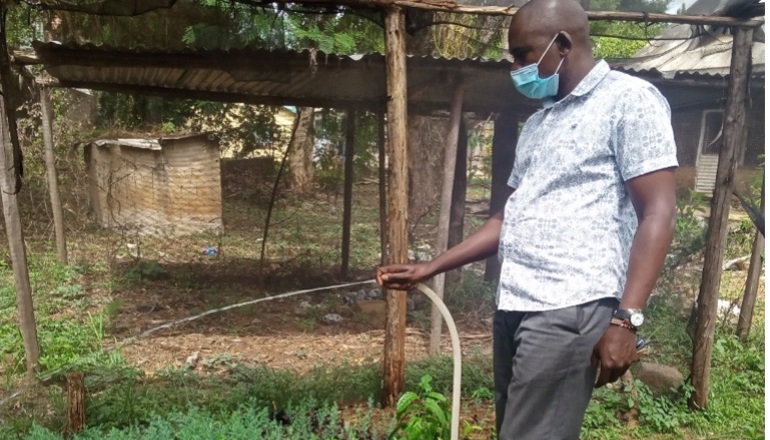Six years ago I returned from a life-changing visit to Kisumu, Kenya (described in this column from 2016). I had been invited by the Rev. Tom Ochuka, then a pastor (now a bishop) in the Africa Inland Church, who asked me to speak about creation care at three of the small churches in his community. Everywhere we stopped, he organized a tree-planting celebration, buying seedlings from the local market for members to plant outside their churches and at one hospital.
The hundred-year-old hospital, Nyakach Dispensary in the hills east of Kisumu, was in dire need of repair and restoration. When I described the hospital’s needs to members of my congregation back home, the suggestion was made to apply for a grant from the Presbyterian Women—a grant that, many reams of paperwork and several months later, we learned that we had received. This $50,000 offering covered more than two-thirds of the hospital’s capital improvement needs, jumpstarting its recognition as a regional health center by the government of Kenya, which then provided more staffing, more medicines, and an improved service road.
Meanwhile, members of the First Presbyterian Church in Jeffersonville raised $900 to incubate a new tree nursery on the grounds of the AIC bishop’s office in Kisumu. As of this year, nursery volunteers and expert growers have distributed more than 50,000 valuable trees to area schools, hospitals, and churches, improving Kenya’s tree canopy with every planting. They have also provided environmental education to farmers and other area residents, and have even larger plans to grow their work.
No single person working alone could have made such a difference. With the prayerful cooperation of hundreds in both Kenya and the U.S., human and ecological health are being improved in one of the world’s most beautiful—and most vulnerable—regions on the edge of Lake Victoria. These volunteers, both Kenyan and American, are living out the hope expressed in Psalm 27 (March 13): “I believe I will see the Lord’s goodness in the land of the living.”
First Sunday in Lent – March 6, 2022
Lent’s first Sunday emphasizes our utter dependence on God:
- Deuteronomy 26:1-11 prescribes bringing the first fruits before the priest while recounting a story characterized by gratitude, reminding hearers of the natural miracle of food.
- Psalm 91:1-2, 9-16 commends security in God alone.
- Romans 10:8b-13 recalls God’s love for all without distinction.
- Luke 4:1-13 shows Jesus’ practice of fasting and ability to withstand temptations.
Second Sunday in Lent – March 13, 2022
Lent’s second Sunday offers various other ecological opportunities:
- In Genesis 15:1-12, 17-18, God invites Abram to consider future generations.
- Psalm 27 offers the ecologically poignant line “I believe I will see the Lord’s goodness in the land of the living.”
- Philippians 3:17—4:1, with its distinction between minds set on earthly treasures and heavenly realities, invites reconsideration of what belonging to God means—renunciation not of God’s creation, but of materialism, which defies God.
- In Luke 13:31-35, Jesus compares his compassion to a mother hen’s care.
Third Sunday in Lent – March 20, 2022
Lent’s third Sunday once again emphasizes food:
- Isaiah 55:1-9 reminds us of a world where food and drink are not commodified, where all are freely invited to “come to the waters.” It commends wise choices, so that we may “eat what is good.”
- Psalm 63:1-8 uses the imagery of drought to describe longing for the rich feast of God’s presence.
- 1 Corinthians 10:1-13 shares the theme of food, remembering the story of manna in the wilderness and the water God gave from the rock.
- Luke 13:1-9 teaches that those who suffer are not necessarily those who sinned. God waits for us all to bear good fruit.
Fourth Sunday in Lent – March 27, 2022
Lent’s fourth Sunday reminds readers to seize the day by responding appropriately to God’s bounteous love:
- Joshua 5:9-12 relates the first day that the children of Israel eat food grown in the land of Canaan.
- Psalm 32 remembers the dangers of drought and flood, and reminds humans that God has taught us the way we should go.
- 2 Corinthians 5:16-21 reminds readers that God’s new creation begins now, in this world, where we might become “the righteousness of God.”
- Luke 15:1-3, 11b-32 narrates a father’s joy when his dissolute son stops squandering his heritage and returns home.
Fifth Sunday in Lent – April 3, 2022
Lent’s fifth Sunday emphasizes God’s gifts manifest often in mundane necessities like water and food:
- Isaiah 43:16-21 describes “a new thing” that God will do: rivers in the desert for the people that God formed “to declare my praise.”
- Psalm 126 remembers God’s restoration in the past and prays for restoration today, like “watercourses in the Negeb,” so that “those who go out weeping, bearing the seed for sowing, shall come home with shouts of joy, carrying their sheaves.”
- Philippians 3:4b-14 ponders Paul’s wish, willingly forfeiting his former status, to know the power of Christ’s resurrection.
- John 12:1-8 tells the story of Mary’s profuse anointing of Jesus, as profuse as the bounty with which God graces the earth.
Passion Sunday – April 10, 2022
Passion Sunday commemorates the holiness of humility:
- Isaiah 50:4-9a expresses reliance on God in the face of human opposition.
- Psalm 31:9-16 could be the prayer not only of the lowly, but of the earth itself, distressed, ignored, “like a broken vessel,” yet praying for God’s favor.
- Philippians 2:5-11, resisting arrogance, looks toward the day when every tongue confesses the self-emptying Christ as Lord.
- Luke 22:14-23:56 begins with Jesus’ last supper, reminding us of God’s presence even in the ordinary gifts of food and drink. It ends with Jesus’ body laid in the earth.
Easter Sunday – April 17, 2022
Easter Sunday is filled with imagery from the natural world:
- Acts 10:34-43 recounts Peter’s realizing for the first time that Jesus “is Lord of all” (verse 36). He emphasizes his growing awareness that the good news is good for everyone. For Peter, this post-resurrection discovery of mercy’s wideness is new.
- Isaiah 65:17-25 speaks of the earth’s restoration as a place where people joyfully live out their natural lives, planted and not uprooted: “for like the days of a tree shall the days of my people be, and my chosen shall long enjoy the work of their hands” (v. 22).
- Psalm 118:1-2, 14-24 uses elements of the natural world—stones and tree branches—to help describe rejoicing.
- 1 Corinthians 15:19-26 celebrates Christ as “first fruits of those who have died.”
- John 20:1-18 relates the disciples’ discovery of Jesus’ resurrection at the garden tomb. Given the creation stories’ attention to plants and planting, and God’s placing the first Adam to tend and keep the garden, Mary was more right than she may have known when she supposed Jesus to be the gardener. Creation comes full circle in God’s new creation.
- Luke 24:1-12 employs the mundane elements of spices and stones to surround the miracle of God’s transcending death.
Second Sunday of Easter – April 24, 2022
The Second Sunday of Easter suffuses all of ordinary life with God’s grace:
- Acts 5:27-32: A newly valiant Peter defies authorities who try to keep him quiet.
- Psalm 118:14-29 reminds us that God’s steadfast love is forever. In particular, it remembers what is undervalued: “The stone that the builders rejected has become the chief cornerstone.”
- Psalm 150 (alternate), and the book of Psalms overall, concludes by celebrating all of life’s dependence on God: “Let everything that breathes praise the LORD!”
- Revelation 1:4-8: God is known as “the alpha and the omega.”
- John 20:19-31: Jesus both breathes the Holy Spirit on disciples and reminds them of the incarnational, fleshly nature of his presence.
Patricia Tull’s bimonthly Working Preacher column, “The Great Community,” focuses on ecological themes for preaching.

